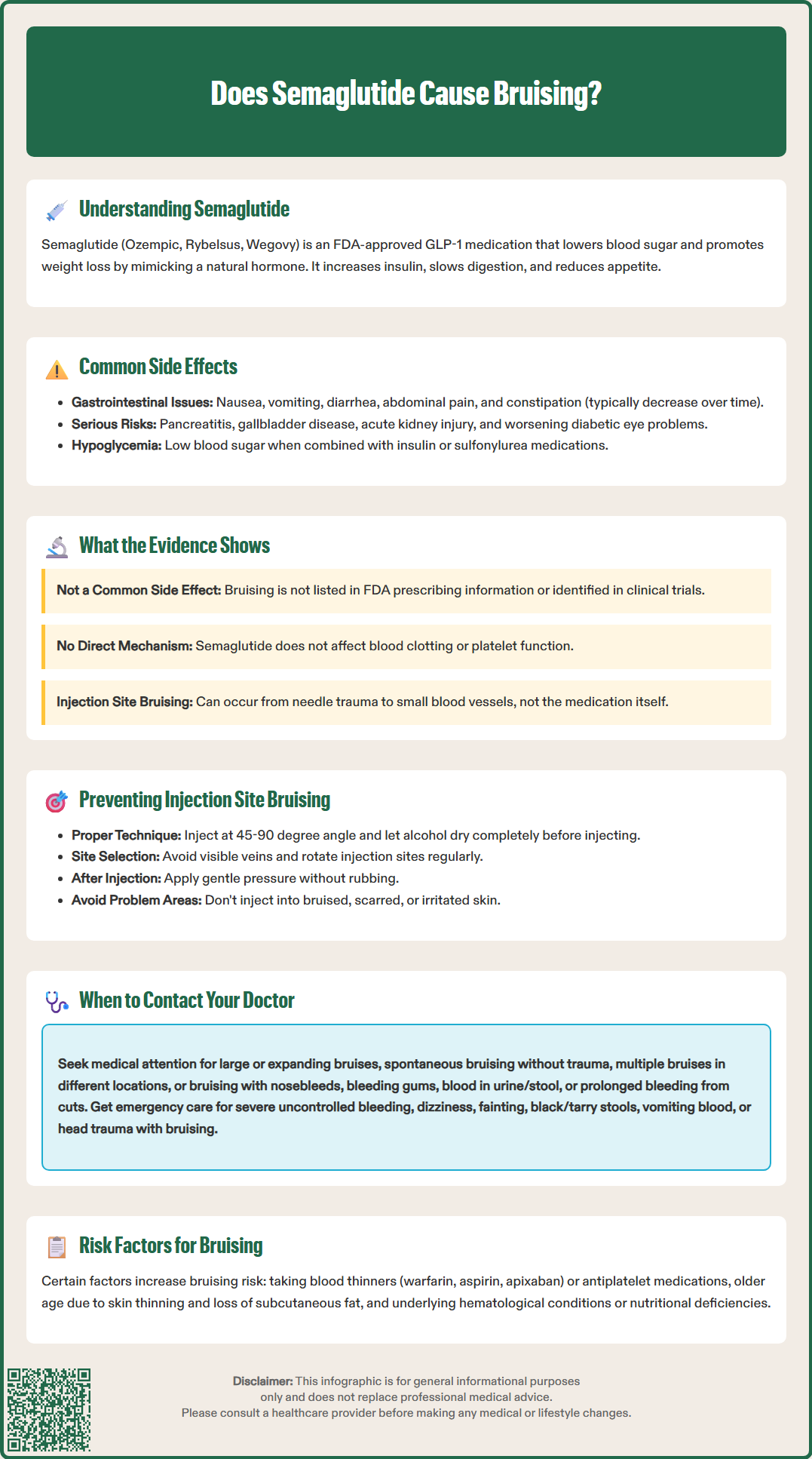LOSE WEIGHT WITH MEDICAL SUPPORT — BUILT FOR MEN
- Your personalised programme is built around medical care, not willpower.
- No generic diets. No guesswork.
- Just science-backed results and expert support.
Find out if you’re eligible

Does semaglutide cause bruising? This question concerns many patients using this GLP-1 receptor agonist for type 2 diabetes or weight management. Semaglutide (Ozempic, Wegovy, Rybelsus) is FDA-approved and generally well-tolerated, with gastrointestinal effects being most common. While systemic bruising is not a recognized side effect of semaglutide, localized bruising can occur at injection sites with the subcutaneous formulations. Understanding the difference between injection-related bruising and unexplained bruising helps patients recognize when medical evaluation is needed. This article examines the evidence on semaglutide and bruising, explains why injection site bruising may occur, and clarifies when to contact your healthcare provider.
Quick Answer: Semaglutide does not cause systemic bruising as a recognized side effect, though localized bruising may occur at injection sites with subcutaneous formulations due to minor needle trauma.
Semaglutide is a glucagon-like peptide-1 (GLP-1) receptor agonist approved by the FDA for the treatment of type 2 diabetes mellitus (under the brand names Ozempic and Rybelsus) and chronic weight management (Wegovy). This medication works by mimicking the action of the naturally occurring hormone GLP-1, which stimulates insulin secretion in a glucose-dependent manner, suppresses glucagon release, slows gastric emptying, and promotes satiety. These combined mechanisms help lower blood glucose levels and support weight reduction in appropriate patient populations.
As with any medication, semaglutide is associated with a range of side effects. The most commonly reported adverse effects are gastrointestinal in nature and include nausea, vomiting, diarrhea, abdominal pain, and constipation. These symptoms are typically mild to moderate in severity and often diminish over time as the body adjusts to the medication. The frequency of these side effects varies by product and dose—for example, nausea occurs in approximately 15-20% of patients using Ozempic for diabetes management, while rates are higher with Wegovy's 2.4 mg dose for weight management.
Injectable semaglutide (Ozempic, Wegovy) may cause injection site reactions such as redness, swelling, or itching at the site of administration. Hypoglycemia may occur, particularly when semaglutide is used in combination with insulin or sulfonylureas. Less common but serious adverse effects include pancreatitis, gallbladder disease, acute kidney injury, and diabetic retinopathy complications (particularly in patients with pre-existing retinopathy and rapid glycemic improvement).
Importantly, semaglutide carries a boxed warning for risk of thyroid C-cell tumors observed in animal studies. It is contraindicated in patients with a personal or family history of medullary thyroid carcinoma (MTC) or in patients with Multiple Endocrine Neoplasia syndrome type 2 (MEN2). Semaglutide is not indicated for use in patients with type 1 diabetes.
Understanding the full spectrum of potential side effects helps patients and clinicians distinguish between expected reactions and those that may warrant further investigation or intervention.
Bruising, or ecchymosis, is not listed as a common or characteristic side effect of semaglutide in the FDA-approved prescribing information. Clinical trials evaluating semaglutide for both diabetes management (SUSTAIN trials) and weight loss (STEP trials) did not identify bruising as a frequent adverse event compared to placebo groups. There is no established pharmacological mechanism by which semaglutide would directly affect coagulation pathways or platelet function that would predispose patients to spontaneous bruising.
However, bruising at injection sites is a recognized phenomenon with any subcutaneous injection, including injectable semaglutide (Ozempic and Wegovy). This type of bruising is typically localized, small, and resolves spontaneously within days to weeks. It results from minor trauma to small blood vessels during needle insertion rather than a systemic effect of the medication itself. The incidence of injection site bruising varies among individuals and may be influenced by injection technique, needle size, anatomical site selection, and individual factors such as skin fragility or use of anticoagulant medications. Note that oral semaglutide (Rybelsus) would not cause injection-site bruising.
Post-marketing surveillance through the FDA Adverse Event Reporting System (FAERS) has occasionally included reports mentioning bruising in association with semaglutide use, but these spontaneous reports do not establish causation and have significant limitations. It is important to distinguish between injection-related bruising and unexplained or widespread bruising, which may indicate an underlying hematological condition, medication interaction, or nutritional deficiency unrelated to semaglutide.
Currently, there is no official link between semaglutide and systemic bruising tendency. Patients experiencing bruising should be evaluated comprehensively to identify the underlying cause, which may be multifactorial and not necessarily attributable to semaglutide therapy.

When bruising does occur in patients using injectable semaglutide, it is most commonly related to the injection process itself rather than a systemic pharmacological effect. Subcutaneous injections involve inserting a needle through the skin into the fatty tissue layer beneath, which can inadvertently puncture small capillaries or venules. When these tiny blood vessels are damaged, blood leaks into the surrounding tissue, creating the characteristic discoloration of a bruise. This is a mechanical phenomenon that can occur with any injectable medication.
Several factors may increase the likelihood of injection site bruising. Injection technique is important—according to manufacturer Instructions for Use and American Diabetes Care and Education Specialists (ADCES) guidance, patients should inject at a 45-90 degree angle (depending on needle length and body habitus), allow alcohol to dry completely before injecting, and avoid injecting into areas with visible veins. Anatomical site selection also matters; areas with thinner subcutaneous fat or more superficial blood vessels may bruise more easily. The recommended injection sites for semaglutide include the abdomen, thigh, and upper arm, and rotating sites regularly can help minimize localized trauma.
Individual patient factors play a significant role as well. Patients taking anticoagulants (such as warfarin, apixaban, or rivaroxaban) or antiplatelet agents (including aspirin or clopidogrel) have an increased bleeding tendency and are more prone to bruising from minor trauma. Nutritional deficiencies, particularly vitamin K deficiency (uncommon in the US except with malabsorption or liver disease), can impair normal clotting mechanisms. Age-related skin changes, including thinning of the dermis and loss of subcutaneous fat, make older adults more susceptible to bruising. Certain medical conditions such as thrombocytopenia, liver disease, or coagulation disorders may also predispose individuals to easy bruising.
To minimize bruising, patients should follow the manufacturer's Instructions for Use, apply gentle pressure after injection without rubbing the site, and avoid injecting into bruised, scarred, or irritated areas.
While minor bruising at injection sites is generally benign and self-limiting, certain patterns or characteristics of bruising warrant prompt medical evaluation. Patients should contact their healthcare provider if they experience large or expanding bruises that continue to grow over several days, as this may indicate ongoing bleeding or a hematoma requiring assessment. Similarly, bruising that occurs spontaneously without any apparent trauma or injection should be investigated, as it may suggest an underlying bleeding disorder or medication interaction.
Multiple bruises appearing simultaneously in various locations, particularly if accompanied by other bleeding manifestations such as nosebleeds, bleeding gums, blood in urine or stool, or prolonged bleeding from minor cuts, may indicate a systemic coagulation problem. Patients should also seek medical attention if bruising is accompanied by severe pain, swelling, warmth, or signs of infection at the injection site, as these symptoms could represent complications such as hematoma, abscess formation, or cellulitis.
Additional concerning features include bruising associated with systemic symptoms such as fever, unexplained fatigue, weight loss, night sweats, or enlarged lymph nodes, which could indicate hematological malignancy or other serious conditions. Patients taking anticoagulant or antiplatelet medications who notice a sudden increase in bruising frequency or severity should have their medication regimen reviewed and potentially their coagulation parameters checked.
Seek emergency care immediately for severe or uncontrolled bleeding, dizziness or fainting, black/tarry stools, vomiting blood, or severe head trauma with bruising. Patients should not discontinue semaglutide without consulting their healthcare provider unless instructed to do so for safety reasons.
Before the appointment, patients should document the location, size, and timing of bruises, note any associated symptoms, and compile a complete list of all medications, supplements, and over-the-counter products they are using. Healthcare providers may perform a physical examination, order laboratory tests including complete blood count, coagulation studies (PT/INR, aPTT), and platelet count, and review medication interactions. In most cases, simple modifications to injection technique or identification of contributing factors will resolve the issue, but thorough evaluation ensures that significant underlying conditions are not missed.
No, bruising is not listed as a common side effect in FDA prescribing information for semaglutide. Clinical trials did not identify systemic bruising as a frequent adverse event, though localized bruising may occur at injection sites with subcutaneous formulations.
Injection site bruising occurs when the needle inadvertently punctures small blood vessels during subcutaneous injection, causing blood to leak into surrounding tissue. This is a mechanical effect related to the injection process, not a pharmacological effect of semaglutide itself.
Contact your healthcare provider if you experience large or expanding bruises, spontaneous bruising without trauma, multiple bruises appearing simultaneously, or bruising accompanied by severe pain, infection signs, or systemic symptoms like fever or unexplained fatigue.
All medical content on this blog is created using reputable, evidence-based sources and is regularly reviewed for accuracy and relevance. While we strive to keep our content current with the latest research and clinical guidelines, it is intended for general informational purposes only.
This content is not a substitute for professional medical advice, diagnosis, or treatment. Always consult a licensed healthcare provider with any medical questions or concerns. Use of this information is at your own risk, and we are not liable for any outcomes resulting from its use.